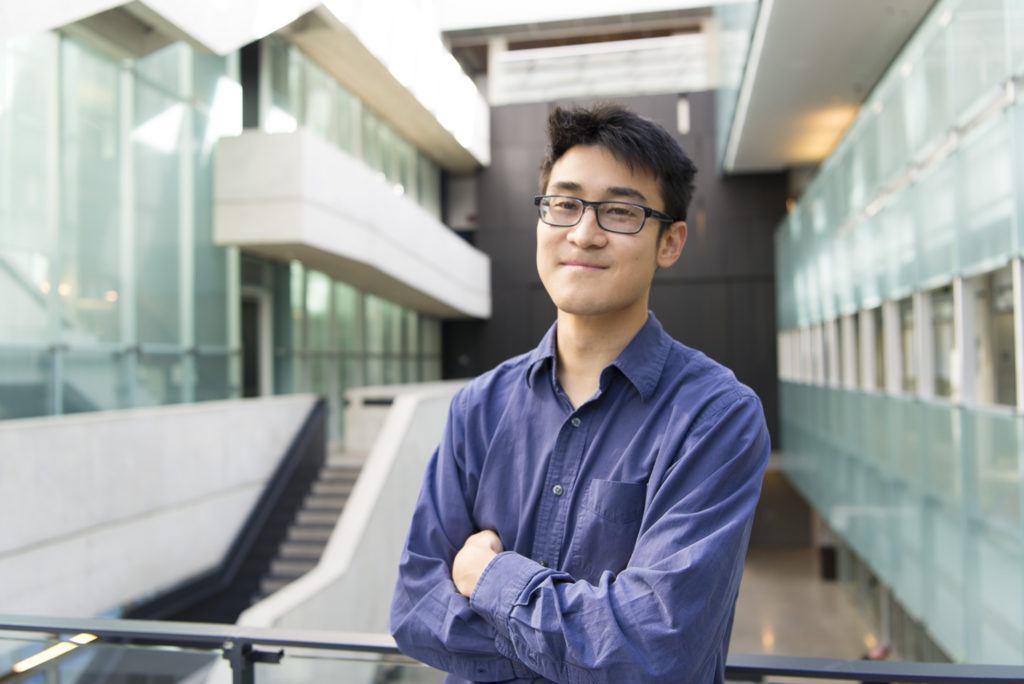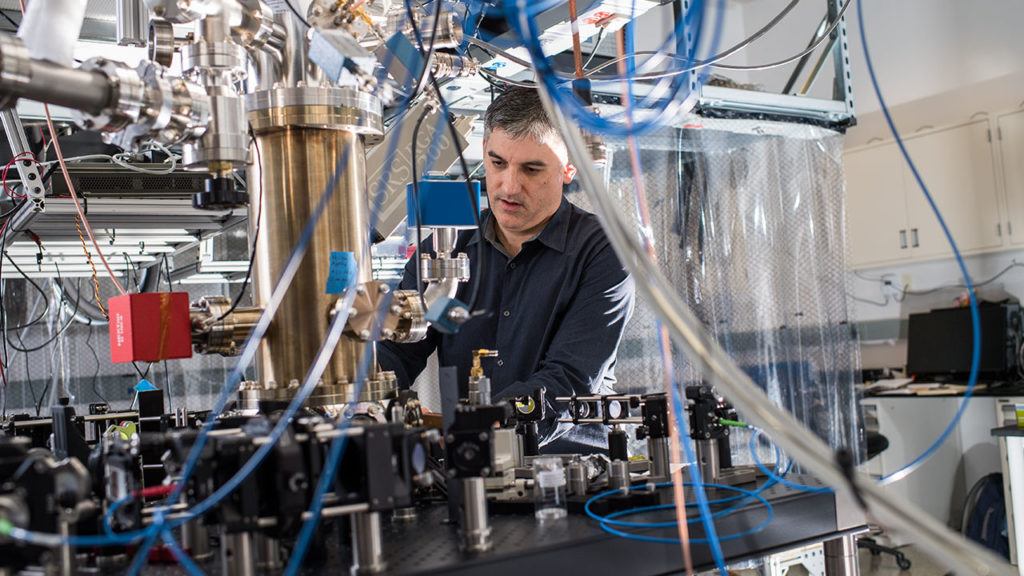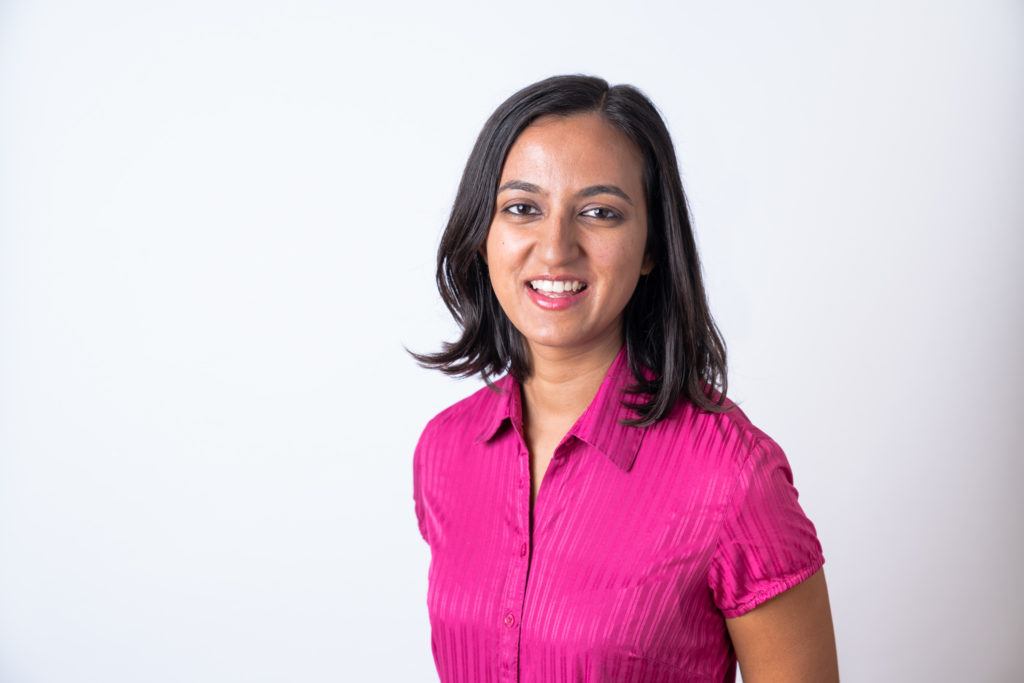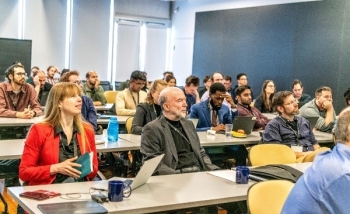Quantum computers are on a cusp.
For decades, scientists have been trying to lay the theoretical foundations and make the experimental breakthroughs necessary to build the first quantum computers. This work continues. But in the last few years, the field has reached a turning point: Quantum computers are no longer just the subject of science. They are now being used to do science.
This raises two kinds of questions. First: How can we build more practical, more stable, more powerful quantum computers? Second: What possibilities are opened by the quantum computers we have right now?
A team of researchers including Perimeter theorist Tim Hsieh, Intel quantum algorithm researcher Sonika Johri, and quantum experimentalist Chris Monroe combined forces to pioneer a new approach in quantum simulation. By choosing the right problem, as they demonstrate, it’s possible to push both quantum computing and quantum science forward.
“I call it the quantum stack,” says Monroe, who heads the Trapped Ion Quantum Information Lab at the University of Maryland and the Duke Quantum Center at Duke University – labs that each contain one of the most advanced quantum computers of its kind. In computer science, the stack goes from hardware at the bottom, through the compilers and programs in the middle, to the user at the top. The user, most often, doesn’t care how the hardware or the software work.
The quantum stack is structured the same way, in this case with Monroe’s hardware at the bottom. In his lab, single ions are brought nearly to a standstill in wells of electric potential: they settle like marbles into egg cartons. They can be “poked,” as Monroe puts it, using lasers. “They’re very cold, very isolated; we have pretty good control over them.” Each ion acts as a single qubit, which is a quantum version of the usual 0 or 1 bit in conventional computers and allows the storage of multiple pieces of information at once. The ions can be entangled with one another: that is, their quantum states can be linked together as if by invisible wires. This setup can be used as a small but robust digital quantum computer.
In the middle of the quantum stack are quantum algorithm researchers like Sonika Johri, who was at Intel at the time of this research. (She is now with the quantum computing company IonQ, co-founded by Monroe.) “In solving a computational problem, you need to design a series of steps. Those steps are called an algorithm,” Johri explains. “Designing a quantum algorithm is basically designing the series of steps you take to set up a certain state on a quantum computer. It’s an exciting mix of computer science and physics.”
At the top of the stack are theorists like Tim Hsieh, with research expertise in both quantum matter and quantum information. Says Hsieh: “My interest is mostly in probing these many qubit systems and trying to engineer new quantum phenomena in these artificial systems.”
Like an engineer studying a complex dam-building problem with a scale model on a wet table, Hsieh hopes to use these controllable quantum systems to learn about harder-to-work-with models of strongly interacting quantum materials. For this project, Hsieh set his sights on creating a “thermofield double state” – or TFD – in the laboratory.
TFDs have attracted interest for several reasons. High among them: TFDs are a kind of trick for simulating thermal states of quantum systems.
Many of the unresolved problems in quantum many-body systems – for example, all the mysteries of high-temperature superconductors – involve thermal states. Yet thermal states are notoriously challenging to simulate precisely in the laboratory.
The normal procedure for simulating a thermal quantum state involves putting the system under study in contact with what’s called a thermal reservoir – a much larger thing that can change the system without changing much itself. It’s like dropping an ice cube into the ocean. Unfortunately, when you do that with a quantum system, everything that’s interestingly quantum about it bleeds out into the environment and is lost in the waves, a process called quantum decoherence.
Introducing a TFD opens up another approach. Instead of putting the fragile quantum system in contact with a thermal reservoir, you put it in contact with a second copy of itself, linked to it via entanglement. Unlike the connection between the ocean and the ice cube, the degree of entanglement can be precisely controlled.
“The TFD consists of two copies of quantum states that are entangled with each other, and the degree of entanglement determines how ‘hot’ or ‘cold’ the original system is,” says Hsieh.
“Now this entanglement can be precisely controlled so that the original copy is in the desired thermal state at a target temperature.”
In other words: the entanglement acts like a thermostat, allowing researchers a new way to control the thermal states of quantum systems.
It’s a powerful technique, so it’s not surprising that the creation of TFDs in the laboratory is on many people’s wish list. Indeed, even as Hsieh was posting his group’s proposals for building TFDs, two other groups posted different approaches. “That just shows the demand for a way to probe TFD states,” says Hsieh. “We think our approach is particularly well suited for near-term experiments.”
But almost more exciting than the fact that the team built a TFD is how they did it, and the powerful tools they developed and used along the way.
Trapped-ion experimentalist Chris Monroe (Image © Cameron Davidson for Science)[/caption]
“So,” Monroe explains, “making a state is the cool thing, but it’s often very hard to come up with the circuit that makes the state you want.” If this were a classical computer, Monroe would need to know which transistors to wire together to form the logic gates that are the heart of all computation. The parallel problem here: Which qubits to entangle in what pattern to create a TFD? Even though the number of qubits is still small, the number of ways in which they can be entangled is huge. Blind guessing won’t work.
“The TFD state is interesting, sure, but how the hell do you make it?” says Monroe. “And that’s really where Tim’s work comes in.”
Instead of taking a blind guess, Tim Hsieh and Perimeter PhD student Jingxiang Wu developed a different way to find the right pattern of entanglement. They used an informed “take a good guess, refine, and guess again” sequence called a quantum approximate optimization algorithm, or QAOA. QAOAs aren’t new, but Hsieh and Wu’s paper was the first to propose using them to create thermal states.
Later, Hsieh linked up with Johri, who had experience implementing quantum algorithms like this new QAOA on trapped ion quantum computers like Monroe’s. “I said, ‘Oh, you could run this algorithm on that hardware,’” Johri remembers. “It looks very efficient and like it might give good results.”
It did. It wasn’t simply a matter of implementing the algorithm and writing the paper: All three researchers describe the back and forth work of building the stack between theory and hardware. And all three describe the intricacies of the results, the kinds of things that can only be learned by trying things out. But the bottom line: this collaboration is the first to show that using a QAOA to design, and then create, an interesting physical state actually works in practice.
The end result: “It’s a powerful new protocol for implementing thermal states,” says Hsieh. “Thermal states are important, and they’re tricky. Now that this protocol exists, I think it could be widely used.”
The project also spotlights how the field of quantum computing has changed – and is now growing fastest and best just where theory and experiment intersect. As recently as five or 10 years ago, the field was quite siloed: Hardware specialists were working on how to create stable qubits, or good quantum gates. Algorithm researchers were concentrating on complexity theory, and thinking of what algorithm might work, without ever thinking about how they might be implemented.
“And as long as quantum computers didn’t exist, that was fine,” says Johri. “People were doing fundamental work on hardware, and very theoretical work on software, and we needed both. But now quantum computers really exist.”
To push quantum computers forward, we need to try them to their limits, and that means finding projects that push the edge of what’s possible at all levels of the stack: theorists with new ideas about what needs to get done and how to do it, quantum programmers who can figure out how to implement it efficiently, and hardware people who can actually make it real in the physical world.
“I think this will be critical to how the field moves forward,” says Johri. “At the edge between hardware and theory is where the whole thing will become real.”
Further exploration
About PI
Perimeter Institute is the world’s largest research hub devoted to theoretical physics. The independent Institute was founded in 1999 to foster breakthroughs in the fundamental understanding of our universe, from the smallest particles to the entire cosmos. Research at Perimeter is motivated by the understanding that fundamental science advances human knowledge and catalyzes innovation, and that today’s theoretical physics is tomorrow’s technology. Located in the Region of Waterloo, the not-for-profit Institute is a unique public-private endeavour, including the Governments of Ontario and Canada, that enables cutting-edge research, trains the next generation of scientific pioneers, and shares the power of physics through award-winning educational outreach and public engagement.
You might be interested in





